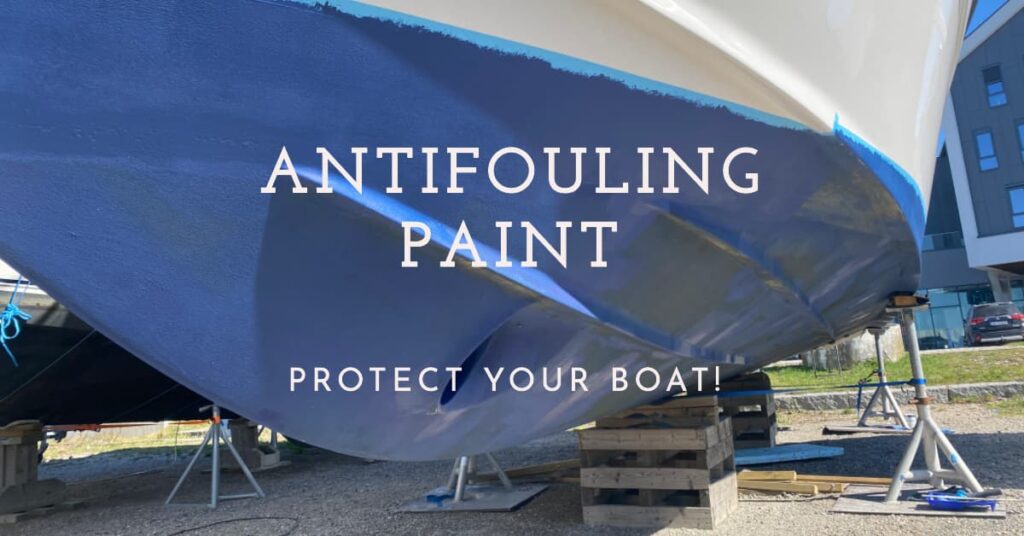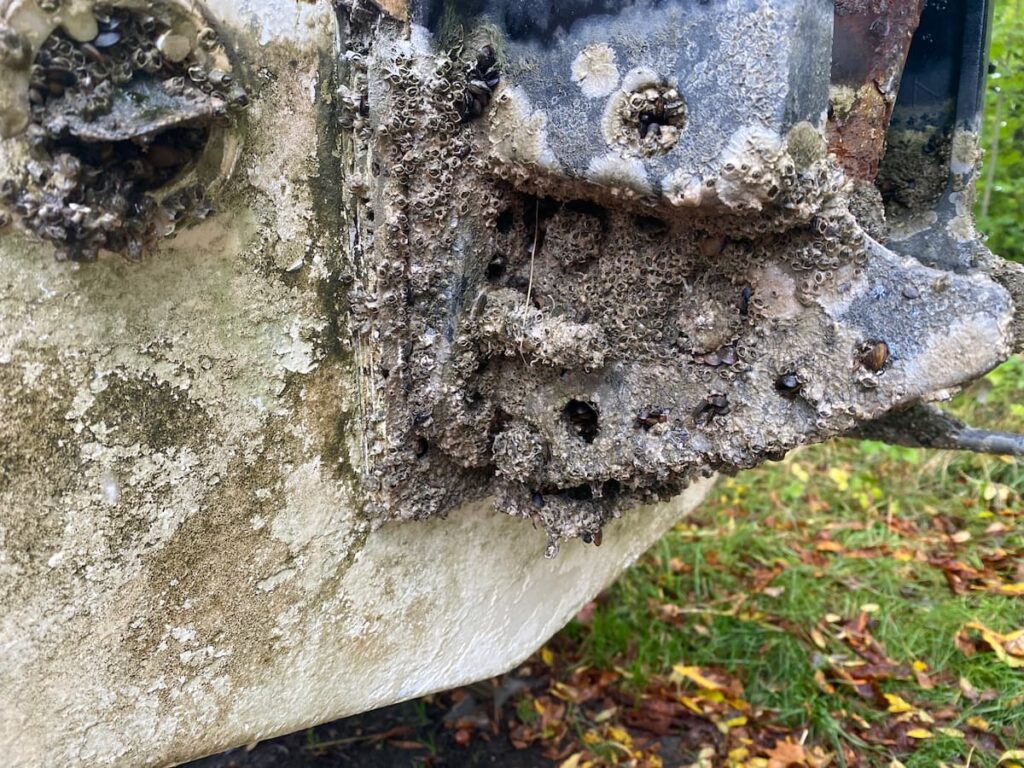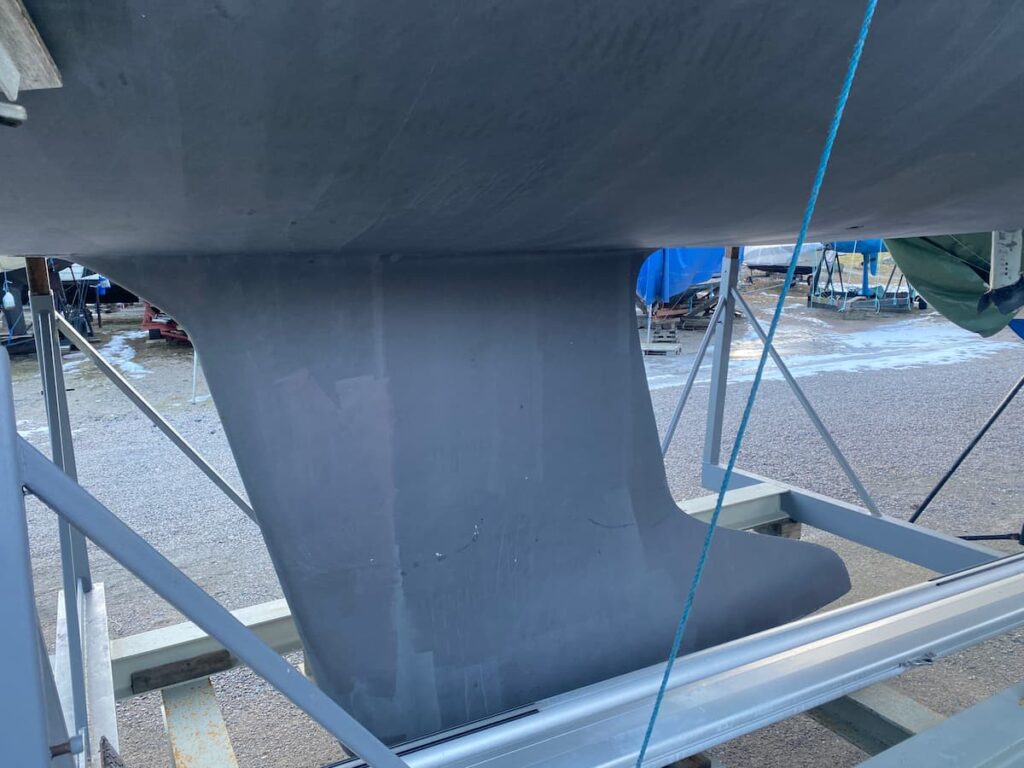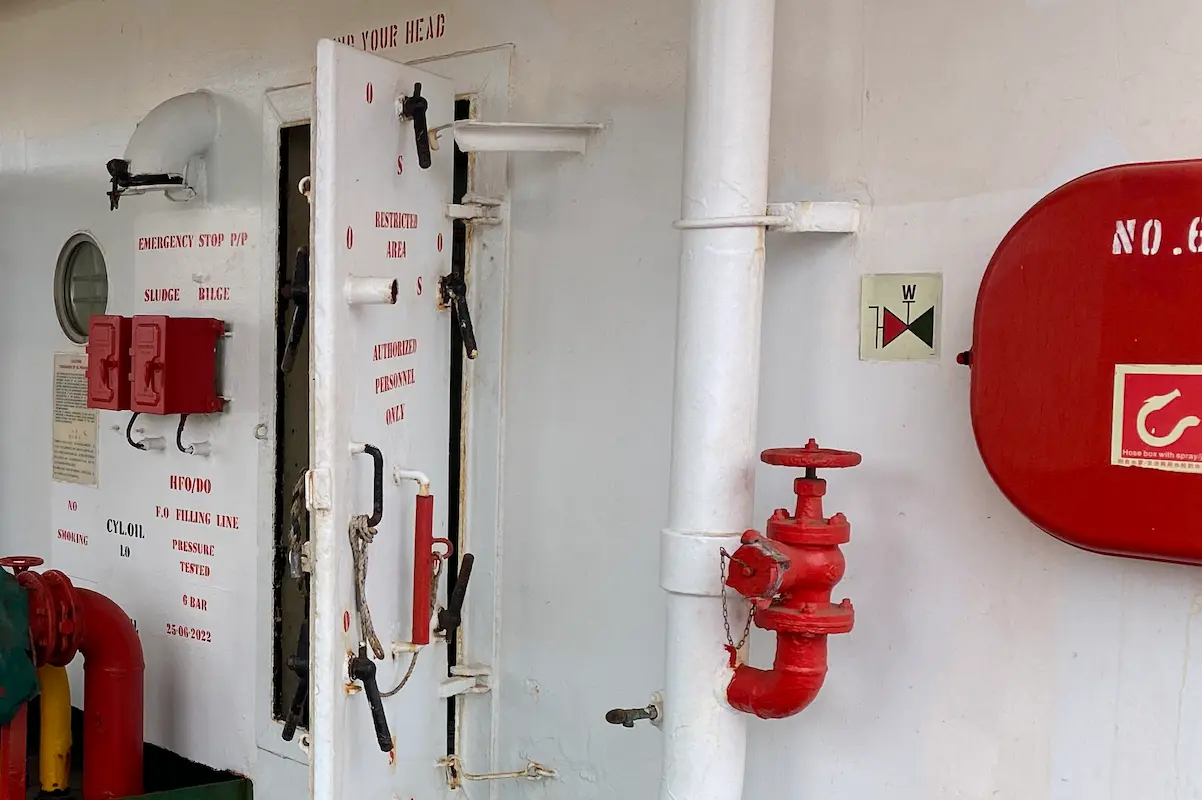Biofouling or the accumulation of marine organisms is a big problem for boat owners. Marine microorganisms like algae, barnacles, and mollusks accumulate on the underwater hull of a boat and quickly become a huge problem. Antifouling paint or bottom paint primarily solves the problem of biofouling.
Let’s dive beneath the surface of a boat’s performance with us as we explore the unseen hero of the marine world – antifouling paint. Join us in understanding its magic, how it defends your boat against stealthy underwater invaders, and why it’s indispensable for every seafarer.

What Is Antifouling Paint Or Bottom Paint
Antifouling paint, also referred to as bottom paint, is a specialized type of coating applied to the underwater portion of a boat’s hull. The reason it’s often referred to as “bottom paint” is simply because it’s applied to the bottom or underwater surfaces of boats. However, the term “antifouling paint” better explains its primary function, which is to prevent fouling, or the accumulation of marine organisms on the hull.
The primary purpose of antifouling paint is to deter the growth and attachment of marine organisms such as barnacles, algae, and mollusks. When these organisms attach to a boat’s hull, they can create a rough surface, which increases drag as the boat moves through the water. This in turn decreases the boat’s speed and fuel efficiency, and can eventually lead to increased wear and potential damage to the hull’s structure.

The paint achieves this protection by slowly releasing biocides, or chemicals toxic to these marine organisms, into the water around the hull. As a result, these organisms are discouraged from settling on the painted surfaces, thus helping to maintain the smoothness and integrity of the hull.
Antifouling paint is of immense importance for marine vessels. It plays a crucial role in maintaining a boat’s performance and durability, particularly for vessels that remain in the water for extended periods. By minimizing biofouling, antifouling paint contributes to improved fuel efficiency, increased speed, and reduced maintenance and repair costs. It’s an essential component of boat maintenance, safeguarding not only the vessel’s performance but also its longevity.
In summary, antifouling paint or bottom paint, as the name suggests, is a protective barrier applied to the underwater surfaces of a boat. Its function is to inhibit the growth and attachment of marine organisms, thereby maintaining the vessel’s speed and efficiency, and extending the lifespan of the hull. This makes it an indispensable tool in the arsenal of any boat owner or operator.
The Need for Antifouling Paint
The ocean is home to a diverse array of marine organisms. Many of these organisms, while integral to the marine ecosystem, can pose significant challenges for boat owners when they attach themselves to the hulls of vessels. This process, known as biofouling, involves the accumulation of organisms such as algae, barnacles, and mollusks on underwater structures.
Boats that are left in water for extended periods are particularly susceptible to biofouling. These marine organisms attach themselves to the hull and, over time, form a layer that increases the roughness of the boat’s surface. This roughness results in increased drag as the boat moves through the water, subsequently decreasing the boat’s speed. Moreover, marine growth can significantly impact the boat’s maneuverability, making it harder to steer and control.
The implications of biofouling extend beyond performance issues. Marine growth, if left unchecked, can potentially lead to serious damage to the hull’s structure. The constant moisture, combined with the corrosive effects of certain marine organisms, can cause the material of the hull to degrade over time. In extreme cases, this degradation can compromise the structural integrity of the boat, potentially leading to leaks or even hull failure.

Additionally, biofouling has a notable impact on a boat’s fuel efficiency. The increased drag caused by marine growth means the boat’s engine has to work harder to achieve the same speed, leading to higher fuel consumption. This not only increases operating costs but also contributes to greater environmental pollution due to increased carbon emissions.
Given these challenges, the use of antifouling paint is essential. By preventing the attachment and growth of marine organisms, antifouling paint allows boats to maintain optimal performance and fuel efficiency. It also protects the hull’s structure, reducing the need for costly repairs and prolonging the lifespan of the vessel. Therefore, the application of antifouling paint is not just a preventative measure but an investment in the long-term health and performance of any marine vessel.
Types of Antifouling Paint
There are several types of antifouling paints, each with distinct properties, benefits, and drawbacks. Understanding these can help boat owners make an informed decision that best suits their needs.
A. Ablative (Self-Polishing) Bottom Paint
How it works: Ablative antifouling paint, often referred to as self-polishing paint, works on a “wash-off” principle. It gradually wears away, or ablates, over time when the boat is in motion. This continuous process exposes a fresh layer of biocide that deters the growth of marine organisms.
Benefits and drawbacks: The key advantage of ablative paint is that it provides a consistently effective level of antifouling, as a new layer of biocide is always being exposed. It also doesn’t build up layers over time, reducing the need for sanding when it’s time to repaint. However, the effectiveness of ablative paint is reliant on the boat’s movement to wear the paint down. This means that boats that are infrequently used might not benefit as much from ablative paint. Additionally, fast-moving boats might wear the paint down too quickly, requiring more frequent reapplication.
Ideal uses: Ablative paint is ideal for slower moving vessels or those that are regularly in use, like cruising sailboats and workboats.
B. Hard (Leaching) Bottom Paint
How it works: Hard, or leaching, antifouling paint has a durable, hard finish. The paint slowly releases biocides over time, without the paint layer wearing away.
Benefits and drawbacks: The main advantage of hard antifouling paint is its durability. It doesn’t wear away like ablative paint, making it a good option for faster boats or those that may come into contact with hard surfaces, as it’s more resistant to abrasion. However, since the paint doesn’t wear away, old layers can build up, making removal a more arduous task. Once all the biocide has leached out, the hard paint layer left behind is no longer effective against fouling.
Ideal uses: Hard bottom paint is suitable for high-speed powerboats or racing sailboats, or boats that are often pulled onto a beach or frequently encounter debris.
C. Hybrid Bottom Paint
How it works: Hybrid bottom paint is a mix of ablative and hard bottom paint technologies. These paints have the durability of hard paints but slowly wear away over time like ablative paints.
Benefits and drawbacks: The primary benefit of hybrid bottom paint is that it provides the best of both worlds – durability and controlled erosion. However, as they are a compromise, they may not provide the full benefits of either type in extreme conditions, such as very high-speed boating or extremely infrequent use.
Ideal uses: Hybrid bottom paints are great for a variety of boats and conditions, making them a versatile choice if you’re unsure about which extreme to lean towards.
D. Eco-friendly Bottom Paint
How it works: Eco-friendly bottom paint uses less harmful or alternative biocides to deter marine growth. Some use natural enzymes or slick coatings to create a surface that marine organisms can’t attach to.
Benefits and drawbacks: The main advantage of eco-friendly bottom paint is its reduced environmental impact. These paints are designed to be less harmful to marine ecosystems. However, the effectiveness of eco-friendly antifouling paints can vary, and some may not be as effective or long-lasting as traditional biocide-based paints.
Ideal uses: Eco-friendly bottom paint is ideal for boat owners who prioritize environmental sustainability and those who boat in waters where traditional antifouling paints are restricted due to environmental regulations.
In conclusion, the type of antifouling paint that is best for your boat will depend on several factors, including the type of boat you have, the waters you typically navigate, your typical boating habits, and your personal preferences regarding maintenance and environmental impact.
Choosing the Right Antifouling Paint
Selecting the correct antifouling paint is a crucial aspect of boat maintenance. The ideal choice of paint can vary significantly based on several factors and failing to consider these can result in ineffective protection against fouling. Here are some key factors to consider:
Factors to Consider
- Type of Boat: The type of boat you own can significantly influence your choice of antifouling paint. Different types of boats have varying speed capabilities and hull materials, which can affect the type of paint that is most suitable. For example, high-speed powerboats generally benefit from hard or hybrid antifouling paints due to their resistance to abrasion, while slower cruising sailboats might do better with ablative paints.
- Typical Waters Navigated: The type of waters you typically navigate also plays a role in the type of paint you should choose. For instance, certain types of marine growth are more prevalent in saltwater than in freshwater, and some are more common in warmer waters compared to colder climates. Additionally, certain water conditions, such as high levels of pollution, may require more robust antifouling measures.
- Boating Habits: How frequently you use your boat and how long it spends in the water can also affect the kind of paint that is best for your situation. Boats that are frequently used and move at slower speeds may benefit more from ablative paints, while boats that are used less often or that travel at higher speeds may need the durability of hard or hybrid paints.
Importance of Professional Consultation
While considering these factors, it can be beneficial to consult with a professional before making your final decision. Experts in marine maintenance and boat care can offer valuable insights based on their knowledge and experience. They can assess your specific situation, taking into account not just the type of boat, navigated waters, and boating habits, but also other factors like local regulations on paint types and your budget.
Professional consultation can help ensure that you’re making the most informed decision possible, maximizing the effectiveness of your antifouling measures and the long-term performance and longevity of your boat.
In summary, choosing the right antifouling paint involves a careful consideration of several factors specific to your boat and boating habits. Professional advice can be invaluable in navigating these considerations and ensuring that you choose the most effective and suitable antifouling paint for your needs.
The Environmental Impact of Antifouling Paint
While antifouling paint plays an important role in maintaining the performance and lifespan of a boat, it is essential to consider its potential environmental impact. Traditional antifouling paints, specifically those containing biocides, can have significant effects on marine ecosystems.
Biocides and Their Effects on Marine Ecosystems
Biocides, the active ingredients in many types of antifouling paints, are designed to deter marine organisms from attaching to the hull of boats. While these substances are effective at preventing biofouling, they can also have harmful effects on non-target organisms in the marine environment.
When antifouling paint leaches biocides into the water, it can create a toxic environment for marine life. Even at low concentrations, these substances can affect the growth, reproduction, and survival of various marine species. For example, certain biocides have been found to be particularly harmful to marine organisms such as fish, shellfish, and invertebrates. This impact on individual species can have broader effects on the overall balance and health of marine ecosystems.
Additionally, the constant leaching of biocides contributes to the accumulation of these chemicals in the marine environment over time. Some of these substances can be persistent, meaning they do not degrade quickly and can continue to affect marine life long after they have been released into the water.
Regulations and Guidelines for Antifouling Paints
In light of these environmental concerns, regulations and guidelines have been established in many parts of the world to control the use of antifouling paints. These regulations often focus on limiting the use of certain biocides deemed particularly harmful to the environment.
For example, in the European Union, the Biocidal Products Regulation regulates the use of antifouling paints and other biocidal products to minimize their impact on the environment. Similarly, in the United States, the Environmental Protection Agency (EPA) has guidelines regarding the use of antifouling paints and has banned certain types of biocides.
These regulations are also supplemented by industry and user guidelines, which provide advice on best practices for using antifouling paint. For example, the International Maritime Organization (IMO) has issued guidelines for the use of antifouling systems on ships to minimize their environmental impact.
As awareness grows about the environmental impact of antifouling paints, more sustainable alternatives are being developed. Eco-friendly antifouling paints, which use less harmful biocides or alternative methods to deter marine growth, are becoming increasingly popular. These paints aim to provide effective antifouling protection while minimizing harm to the marine environment.
In conclusion, while antifouling paint is crucial for maintaining the performance and integrity of boats, it is important to use these products responsibly. This includes understanding the potential environmental impact of these paints, adhering to regulations and guidelines, and considering more environmentally friendly options when available.
Conclusion
In navigating the open seas or the calm waters of our favorite marina, the importance of antifouling paint becomes abundantly clear. Whether it’s ensuring the streamlined glide of your speedboat as it effortlessly cuts through the waves or maintaining the integrity of your cherished sailboat, antifouling paint is integral to the optimal performance and longevity of our marine vessels.
Consider the story of the seasoned mariner, Jack. He has spent years sailing his sturdy sloop around the coastal waters of Maine. Jack’s fondness for his boat meant he was keen on keeping it in prime condition. He quickly learned the value of a good quality antifouling paint when he noticed the speed and fuel efficiency of his boat starting to dwindle due to marine growth on the hull. After applying the correct type of antifouling paint suited to his boating needs, not only did his boat regain its former performance, but he also noticed the hull was protected from potential structural damage caused by persistent marine organisms.
However, as crucial as antifouling paint is to our boats, we must remain conscientious of the potential environmental impacts. As we’ve learned from the story of Jack, the right type of paint can make a huge difference. But it’s equally important to ensure that this choice respects the delicate balance of our marine ecosystems. By adhering to the regulations and guidelines put in place by maritime organizations and environmental authorities, we can contribute to the well-being of the waters we love to explore.
Just as Jack, who after understanding the potential ecological impacts of certain biocides, opted for an eco-friendly antifouling paint. His choice demonstrated that it’s entirely possible to balance effective boat maintenance with environmental stewardship.
Ultimately, our interactions with the marine world should always be marked by respect and responsibility. It’s upon us to make informed decisions, understanding not only our boats but also the environments they inhabit. By choosing the right antifouling paint, we ensure the longevity of our boats, the richness of our sailing experiences, and the preservation of our precious marine ecosystems for future generations of mariners to come. So, let’s chart our course with care, just like Jack, ensuring we leave only waves behind.
- 11 Boat Salvage Yards in Texas – January 18, 2025
- 7 Boat Salvage Yards in Michigan – January 15, 2025
- Fire Hose SOLAS Requirements, Regulation 10: Ensuring Maritime Safety – January 9, 2025




